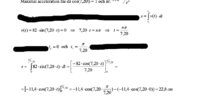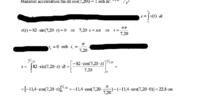Hello, ran into a problem that I would appreciate if someone could help me out with.
Problem
Harmonic oscillation:

v=speed (cm/s)
t= seconds
Find the distance the object is moving between the turning points
Solution

My question
How do I really know that the time calculated in the solution is the time that passes by when the object moves between two turning points? When I first saw the solution I thought that t1 accounted for half of the time (assuming the full time would be between two turning points), which in that case would give t1*2. Hope that I make some sense to you?
Problem
Harmonic oscillation:
v=speed (cm/s)
t= seconds
Find the distance the object is moving between the turning points
Solution

My question
How do I really know that the time calculated in the solution is the time that passes by when the object moves between two turning points? When I first saw the solution I thought that t1 accounted for half of the time (assuming the full time would be between two turning points), which in that case would give t1*2. Hope that I make some sense to you?


